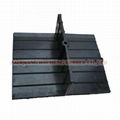| Model: | - |
|---|---|
| Brand: | DACHENG |
| Origin: | Made In China |
| Category: | Construction & Decoration / Other Construction Materials |
| Label: | bridge rubber bearin , rubber bearing , seismic isolation |
| Price: |
US $42
/ pc
|
| Min. Order: | 5 pc |
| Last Online:22 May, 2018 |
1. Application of HDR high damping rubber bearing products for earthwork
High damping rubber bearings(HDRB) are used in bridges and structures. The principle is different from mass—spring system with single degree of freedom of EBP, and they can achieve transverse and vertical damping effect on the basis of two-wad, especially applicable to the basic vibration reducing system. For the regions which have special requirements on the environment. Such as residential areas, high-tech industrial parks, nature reserves and etc, the bearings can be widely used.
They are of environment-friendly products, made in China now. At present they are mainly used in construction projects.
High damping rubber bearings have the following series: TJGZ-JZ-HDRB.
2. Description of HDR high damping rubber bearing products for earthwork
High Damping Rubber Bearings (HDRB) are large laminated elastomeric bearings which are ideal for seismic isolation with one device - supporting the structure, for base isolation, providing elastic restoring force and required amount of damping up to a maximum of 10-15% of critical. Moderate damping is achieved with this type of bearing.
3.Features of HDR high damping rubber bearing products for earthwork
HDRB isolation bearings are vertically stiff, capable of supporting vertical gravity loads, while being laterally flexible, capable of allowing large horizontal displacements. In effect, the ground is allowed to move back and forth under a base isolated during an earthquake, while leaving the building to remain "stationary."
By means of its flexibility and energy absorption capability, with HDRB rubber bearings base isolation system partially reflects and partially absorbs some of the earthquake input energy before this energy can be transmitted to the structure. The net effect is a reduction of energy dissipation demand on the structural system, resulting in an increase in its survivability.










